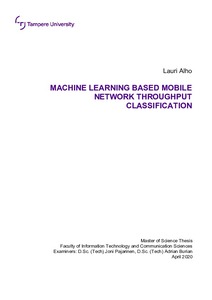Machine Learning Based Mobile Network Throughput Classification
Alho, Lauri (2020)
Alho, Lauri
2020
Tietotekniikan DI-tutkinto-ohjelma - Degree Programme in Information Technology, MSc (Tech)
Informaatioteknologian ja viestinnän tiedekunta - Faculty of Information Technology and Communication Sciences
This publication is copyrighted. You may download, display and print it for Your own personal use. Commercial use is prohibited.
Hyväksymispäivämäärä
2020-05-27
Julkaisun pysyvä osoite on
https://urn.fi/URN:NBN:fi:tuni-202004294310
https://urn.fi/URN:NBN:fi:tuni-202004294310
Tiivistelmä
Identifying mobile network problems in 4G cells is more challenging when the complexity of the network increases, and privacy concerns limit the information content of the data. Classifying cells automatically into normal and problematic ones can increase Quality of Service of User Equipment by reducing the time of locating problematic cells in mobile networks. Despite the positive effect of using a machine learning model to automatically cluster problematic cells, the research has been focused on methods that use data from both the service provider and the user’s side. A search of the relevant work did not yield any research where network throughput classification would have been performed on a cell level with the information gathered only from the service provider's side.
This thesis studies methods to classify 4G cells into problematic and normal ones with a low number of expert-labelled data. The goal of this research is to create a working machine learning model and to find the model architecture which classifies cells correctly with the best performance. To support these objectives, related work is studied in the field of mobile networks and Machine Learning. Also, the used dataset is studied, and data processing methods are created. Multiple model architectures are created, and experiments are made to find the best model with selected performance metrics. Precision, recall and Precision-Recall Area Under Curve are used to evaluate the models.
As a result, this work proposes a data-driven machine learning model for identifying 4G cells that have fundamental network throughput problems. The proposed model takes advantage of clustering and deep neural networks. The model learns its parameters from both unlabelled data and a small number of expert-labelled data. To achieve case-specific classification, this work proposes a model that contains a multiple clustering models block for capturing features common for problematic cells. The captured features of this block are then used as an input to a deep neural network. Experiments show that the proposed model outperforms a simple baseline classifier in identifying cells with network throughput problems. To the best of the author’s knowledge, this work identifies a new research area that focuses on identifying throughput problems in cells.
This thesis studies methods to classify 4G cells into problematic and normal ones with a low number of expert-labelled data. The goal of this research is to create a working machine learning model and to find the model architecture which classifies cells correctly with the best performance. To support these objectives, related work is studied in the field of mobile networks and Machine Learning. Also, the used dataset is studied, and data processing methods are created. Multiple model architectures are created, and experiments are made to find the best model with selected performance metrics. Precision, recall and Precision-Recall Area Under Curve are used to evaluate the models.
As a result, this work proposes a data-driven machine learning model for identifying 4G cells that have fundamental network throughput problems. The proposed model takes advantage of clustering and deep neural networks. The model learns its parameters from both unlabelled data and a small number of expert-labelled data. To achieve case-specific classification, this work proposes a model that contains a multiple clustering models block for capturing features common for problematic cells. The captured features of this block are then used as an input to a deep neural network. Experiments show that the proposed model outperforms a simple baseline classifier in identifying cells with network throughput problems. To the best of the author’s knowledge, this work identifies a new research area that focuses on identifying throughput problems in cells.
